
Jacopo Bellini was one of the founders of the Renaissance style of painting in Venice and northern Italy. His sons Gentile and Giovanni Bellini, and his son-in-law Andrea Mantegna, were also famous painters.
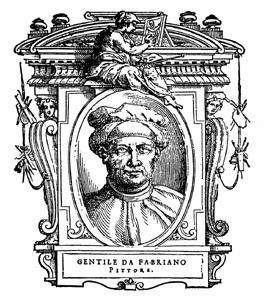
Gentile da Fabriano was an Italian painter known for his participation in the International Gothic painter style. He worked in various places in central Italy, mostly in Tuscany. His best-known works are his Adoration of the Magi from the Strozzi Altarpiece (1423), and the Flight into Egypt. Following a visit to Florence in the 1419, he came in contact with humanism, which influenced his work throughout the rest of his career. He became highly influential for other painters in Florence, especially because of his use of detail based on the observations he made of the natural world.

Vincenzo Foppa was an Italian painter from the Renaissance period. While few of his works survive, he was an esteemed and influential painter during his time and is considered the preeminent leader of the Early Lombard School. He spent his career working for the Sforza family, Dukes of Milan, in Pavia, as well as various other patrons throughout Lombardy and Liguria. He lived and worked in his native Brescia during his later years.

The Adoration of the Magi is a painting by the Italian painter Gentile da Fabriano. The work, housed in the Uffizi Gallery in Florence, Italy, is considered his finest work, and has been described as "the culminating work of International Gothic painting".
The decade of the 1420s in art involved some significant events.

The Madonna of Humility is a tempera-on-panel painting by the Italian late medieval artist Gentile da Fabriano, dating from around 1420-1423 and housed in the Museo nazionale di San Matteo, Pisa.

The Adoration of the Christ Child is a tempera and gold on panel painting by the Italian late medieval artist Gentile da Fabriano, dating from around 1420–1421 and housed in the Getty Center of Los Angeles, United States.
The Master of Staffolo was an anonymous late-Gothic style painter active in the region of Marche and Umbria.

Madonna and Child is a tempera on panel painting of the enthroned Madonna and Child by Gentile da Fabriano. At its base are small angel musicians. It is now in the Galleria Nazionale dell'Umbria in Perugia.
Madonna and Child can refer to:
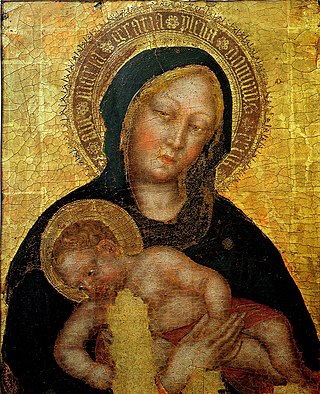
Madonna and Child is a c. 1400-1405 tempera and gold leaf on panel painting by Gentile da Fabriano, now in the Pinacoteca Nazionale di Ferrara. It is signed at the base. Before being restored in 1980 it was thought to be by a follower of the artist due to thick repainting on the whole work.

Madonna and Child is the only surviving fragment of a larger tempera and gold on panel painting by Gentile da Fabriano, executed c. 1423–1425. It is now in the Berenson collection at Villa I Tatti in Settignano. It is dated to the artist's Florentine period due to stylistic similarities with the Madonnas in his Quaratesi Polyptych and Yale Madonna

Madonna and Child is a tempera and gold on panel painting by Gentile da Fabriano, executed c. 1424, now in the Yale University Art Gallery in New Haven. It is signed on the left jamb "Gent / Fabriano". Previously traditionally dated to 1420–1423, the new accepted dating is based on similarities between the background architecture and the north door of the Florence Baptistery, completed by Lorenzo Ghiberti in 1424.

Madonna and Child is a tempera and gold on panel painting by Gentile da Fabriano, executed c. 1420–1423, now in the National Gallery of Art in Washington, D.C. The work is generally identified as one of the first the artist produced in Florence, where he had arrived in summer 1420, at roughly the point at which he was working on the Pala Strozzi. It may have been the central panel of a polyptych, the rest of which is now lost.
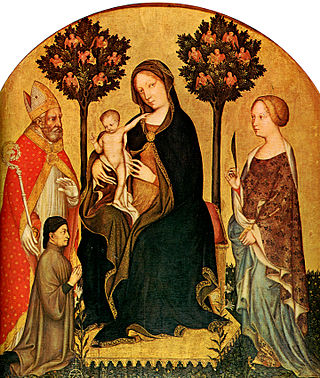
Madonna and Child with Two Saints and a Donor is a c.1395-1400 tempera and gold leaf on panel painting by Gentile da Fabriano, the earliest surviving major work by the artist. Probably painted for the church of Santa Caterina in Castelvecchio in Fabriano, near to which it is now in the Gemäldegalerie in Berlin.
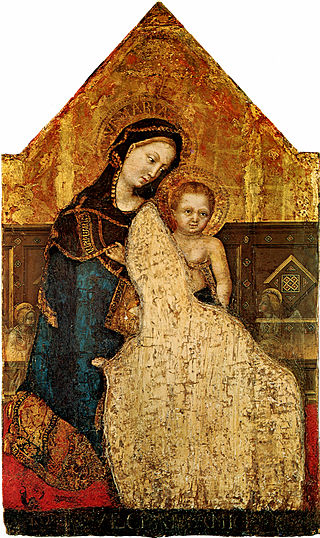
The Velletri Madonna is a tempera and gold on panel painting by Gentile da Fabriano, executed c. 1426-1427, the only surviving work from his stay in Rome. A Madonna of humility, it was in the church of Santi Cosma e Damiano until 1633 when Ludovico Ciotti di San Paolo, General of the Third Order Franciscans, donated it to the Church of Sant'Apollonia in Velletri. It is now in the Diocesan Museum in Velletri. A restoration in 1912 restored the top to its original triangular form.
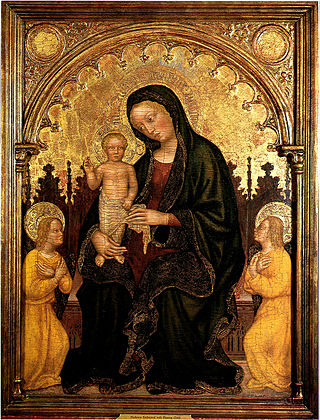
Madonna and Child Enthroned with Two Angels is a c.1410-1415 tempera and gold on panel painting by Gentile da Fabriano. Its original provenance is unknown, though its small size probably means it was made for private devotion. It is first recorded in the early 20th century, when it was in the Casa Persicini in Belluno, which suggests it links to the painter's time in Venice. It is now in the Philbrook Art Center in Tulsa, Oklahoma.

Madonna and Child with Saints Julian and Lawrence is a c. 1423–1425 tempera and gold leaf on panel painting by Gentile da Fabriano. It is now in the Frick Collection in New York. To the left is saint Lawrence in a deacon's dalmatic and holding the gridiron of his martyrdom, whilst to the right is Saint Julian.

The Intercession Altarpiece is a five-panel tempera and gold on panel painting by Gentile da Fabriano, produced during his stay in Florence from 1420 to 1423. Its original location is unknown, though it is now in the sacristy of Chiesa di San Niccolò Oltrarno in Florence. It is named after its central panel of Jesus and the Virgin Mary interceding to God the Father. The two outermost panels show Louis of Toulouse and Bernard of Clairvaux. The two inner side-panels show the Resurrection of Lazarus and a group of three saints.
Madonna and Child with Two Saints may refer to:
















